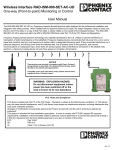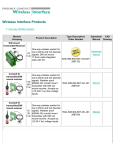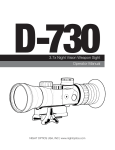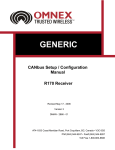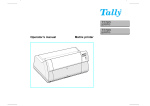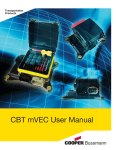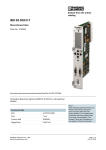Download Wireless Interface RAD-ISM-900-SET-UD-ANT
Transcript
Wireless Interface RAD-ISM-900-SET-UD-ANT One-way (point-to-point) Monitoring or Control User Manual ) ) ) Figure 1. RAD-ISM-900-SET-UD-ANT Notice: These devices must be wired in accordance with Class I, Division 2 wiring methods as described in the National Electric Code, Article 501-4(b) or the authority having jurisdiction. Transmitter unit is to be used with a purely resistive antenna when installed in Class I, Division 2 areas. V TIO N S IN S P IRI N G INNOVA 1 The RAD-ISM-900-SET-UD-ANT is a Frequency Hopping Spread Spectrum radio designed for the professional installation and integration with other products. When installed with an approved antenna and cable, the system integrator needs to make sure that the unit’s FCC label, or a copy of the FCC label, is clearly visible on the outside of the integrated product. The RAD-ISM-900-SET-UD-ANT is approved within the 902 to 928 MHz ISM Band under Part 15 of the FCC Rules and Regulations. Frequency Hopping Spread Spectrum technology was originally developed by the U.S. military to prevent interference or interception of radio transmissions on the battlefield. Frequency hopping devices concentrate their full power into a very narrow signal and randomly hop from one frequency to another within a designated frequency band. If they encounter interference on a particular frequency, the devices error-check the affected data, hop to another point on the spectrum, and resume communications on subsequent hops. Since there are always spaces without interference somewhere in the allotted radio spectrum, a frequency hopping device will use those spaces to complete a transmission. WARNING: EXPLOSION HAZARD Do not disconnect equipment unless power has been switched off or the area is known to be non-hazardous. FCC Rules and Compliance This device complies with Part 15 of the FCC Rules. Operation is subject to the following two conditions: (1) This device may not cause harmful interference, and (2) this device must accept any interference received, including interference that may cause undesired operation. Changes or modifications not expressly approved by Phoenix Contact Inc. will void the user’s authority to operate the equipment. This product is intended for fixed installation applications. In order to comply with FCC/ISC adopted RF exposure requirements, installation of this transmitter system’s antenna must be performed in a manner that will provide at least a 6 foot (2m) clearance from the front radiating aperture to any user or member of the public. FCC ISC UL 2 Part 15.247 RSS 210 Class I, Division 2 (Groups A,B,C,D) RAD-ISM-900-UD Transmitter 4-20mA Current Loop with 2-Wire Device Note: Incorrect antenna placement and positioning can have a significant impact on the performance of the RAD-ISM-900-SET-UD-ANT. Keep the Omni antenna vertical and mounted as high as possible. Extra cable may be required to achieved Line-of-sight (LOS) between the Transmitter and the Receiver. For applications that require the antenna to be mounted away from the Transmitter, please contact your distributor for cable and antenna options. Always follow the mounting instructions and proper grounding procedures as outlined in the antenna manuals. 3 RAD-ISM-900-UD Transmitter 4-20mA Current Loop with 3-Wire Device 4 RAD-ISM-900-UD Transmitter 4-20mA Current Loop with 4-Wire Device 5 RAD-ISM-900-UD Receiver Block Diagram Receiver Indicator LEDs RF LED - Flashes once every two seconds when transmitter is OFF or out of range. - Flashes rapidly when signal strength is marginal. - Solid green when a secure link is established. LEDs 1 & 2 - Show status of discrete inputs 1 & 2. Solid green = ON. RF Link: Internal dry contact Form C relay. May be wired as Normally Open (NO) or Normally Closed (NC). This relay is activated when a good Radio (RF) Link is established between the Receiver and its matched Transmitter and Receiver. This discrete output defaults to the normal position as shown in the Receiver Block Diagram. Discrete Outputs 1 & 2: Internal dry contact Form C relays. May be wired as NO or NC. These relays are activated when voltage is applied to Discrete Inputs 1 & 2 at the Transmitter. DEFAULT STATE: When Link is lost between the Transmitter and Receiver, these discrete outputs MAINTAIN LAST STATE. Analog Output: The 4-20mA Current Output replicates the status of the 4-20mA Current Input at the Transmitter. DEFAULT STATE: When Link is lost between Transmitter and Receiver, the analog output MAINTAINS LAST STATE. 6 RAD-ISM-900-UD Receiver Wiring Example A 7 RAD-ISM-900-DC Receiver Wiring Example B 8 Note: The RAD-ISM-900-UD Receiver Analog Output is a 3-wire device and should be wired to the RTU/PLC just as you would a normal 3-wire current loop device.This wiring configuration is for the Receiver only and must be followed regardless of the type of current loop device on the Transmitter side of the loop (i.e. 2-wire, 3-wire, or 4-wire). Example A RF Link contact is wired to a warning light using the (NC) contact. As soon as the RF Link has been established, this contact will go to Open and the warning light will go out. The 4-20mA Analog output has been wired directly to a meter or RTU/PLC device and will MAINTAIN LAST STATE if the RF Link is lost. Discrete Output 1 has been wired through the (NO) contact. When voltage is applied to the Discrete Input 1 side of the Transmitter, this contact will go Closed, and the pump will start. Example B RF Link contact is wired to a warning light using the (NC) contact. As soon as the RF Link has been established, this contact will go to Open and the warning light will go out. The 4-20mA Analog output has been wired directly to a meter or RTU/PLC device and will MAINTAIN LAST STATE if the RF Link is lost. An interesting feature in this example is wiring of the pump. Discrete Output 1 has been wired through the (NO) contact, and through the RF Link (NO) contact. This immediately shuts off the pump if the RF Link is lost. By wiring through the RF Link contact this way, the RF Link contact will go Open when the RF Link is lost, and the pump will shut down. This overrides the default for Discrete Output 1, which MAINTAINS LAST STATE. Default OFF Wiring If either one or both of the Discrete Outputs and/or the Analog (4-20mA) are required to default OFF upon loss of the RF Link with the Transmitter, the RF Link Output can be used to provide a Default OFF state. Discrete Wiring By wiring the Discrete Output(s) in series through the (NO) contact of the RF Link, the LAST STATE of the Discrete Output(s) will be over-ridden and forced to go Open. Note: Current rating of RF Link contact is 0.5A max. 9 Analog (4-20mA) Wiring Likewise, if the Analog signal is required to drop to zero (0 current) when RF Link is lost, it can be wired in series to the RF Link Output in this fashion. Note: Either the discrete Outputs or the Analog can be wired through the RF Link contacts but not both! Maximum OFF voltage for the discrete input is 60VAC. Use of a 2Watt 10k ohm resistor at 110VAC in parallel across the input will help ensure minimum and maximum ON and OFF states. Adding an Extra or Spare Receiver to Your System 1) Remove the HopKey from the existing Receiver by the divots on either side of the enclosure and remove the circuit board (refer to the photographs below). Remove the HopKey and re-insert the circuit board into its enclosure. When re-inserting, line up the terminal labels on the side of the enclosure with the terminal labels on the top of the circuit board to prevent it being installed backward. 2) Remove the spare Receiver from its enclosure. 3) Insert the HopKey from the original Receiver into the spare Receiver. Reinsert the circuit board into the enclosure. Once power is applied to the spare Receiver, it will memorize the identification, hop frequencies and hop sequence of the Transmitter. This takes a few seconds upon power up. If power is removed, it will retain this information, even if the HopKey is removed. Now your spare Receiver, along with the original Receiver, will respond to signals from the Transmitter. Ensure you are using an Omni directional antenna at the Transmitter if the Receivers are off in different directions, since Yagi directional antennas only send radio signals in one direction. 10 Specifications Transmitter Receiver 902 to 928 MHz Frequency Hopping Spread Spectrum 12 to 30VDC regulated 1.8 Watts (average) / 8.4 Watts (peak); 75mA @ Power Consumption 2 Watts (85mA @ 24VDC) 24VDC (average) / 350 mA @ 24VDC (peak) -40°C to 70°C Temperature Range (-40°F to 158°F) Humidity N/A 0% to 95% (non-condensing) 1 x 4-20mA analog Inputs N/A (250 ohm input impedance) 2 x 5 to 30V AC/DC discrete N/A 1 x 4-20mA analog (12-bit Outputs N/A resolution) 3 x 120VAC 0.5A discrete N/A (dry contact) 0.5A @ 125VAC discrete Maximum Relay Current N/A (1,2 and RF Link) Range 4 to 5 miles (Omni), >15 miles (Yagi) LOS 150 to 1350 ohms for power Maximum Loop N/A supply voltages of 12 to Impedance 30VDC* Dimensions 4” x 4.5” x 0.7” (102mm x 114mm x 18mm) Transmit Power 1 Watt N/A Repeatability (4-20mA) N/A 0.02% Accuracy N/A 0.2% of full scale Mounting DIN-rail mount Environmental NEMA 1 (equivalent to IP30) USA - FCC 15.247 Approvals Canada - ISC RSS 210 UL - Class I, Div. 2 (Groups A,B,C,D) *Maximum loop impedance = (VIN -9V/20mA) Frequency Technology Power Source 11 USA Phoenix Contact Inc. P.O. Box 4100 Harrisburg, PA 17111-0100 Phone: 800-888-7388 717-944-1300 Technical Service: 800-322-3225 Fax: 717-944-1625 E-mail: [email protected] Website: www.phoenixcon.com Canada Phoenix Contact Ltd. 235 Watline Avenue Missisauga, Ontario L4Z 1P3 Phone: 905-890-2820 Technical Service: 800-890-2820 Fax: 905-890-0180 E-mail: [email protected] Website: www.phoenixcon.com Omnex Controls Corporate Headquarters 74-1833 Coast Meridian Road Port Coquitlam, BC V3C 6G5 Phone: 604-944-9247 Fax: 604-944-9267 Email: [email protected] Website: www.omnexcontrols.com V TIO N S IN S P IRI N G INNOVA © 2005 Phoenix Contact Inc. 12 L001942:05.05














